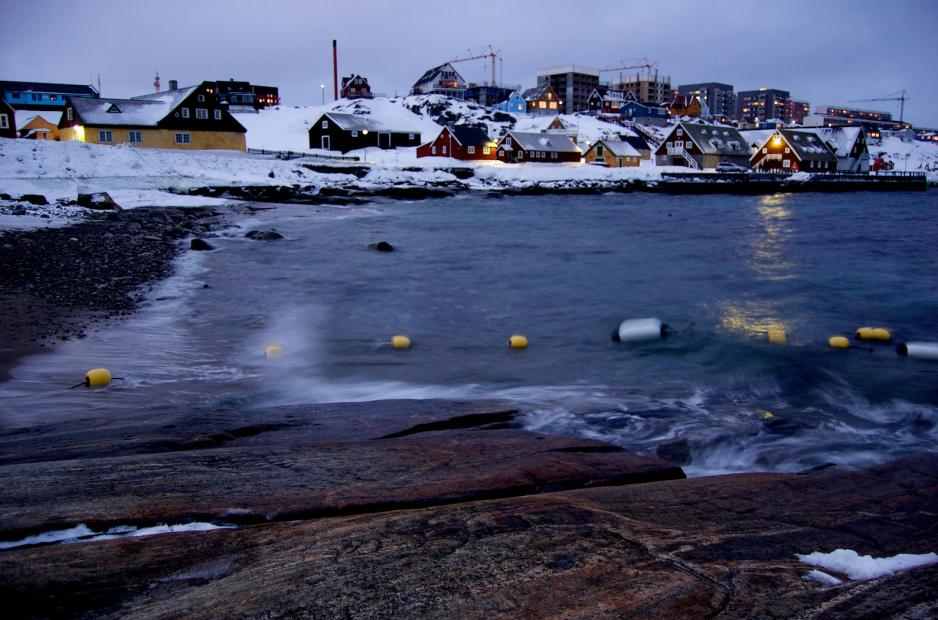Op ed: Going Local! - Reaching High Goals From the Ground Up

- Indigenous residents of the Arctic, as here in Nuuk, Greenland, will be adapting to radical climate change. To address these challenges we need to go local, writes Christin Kristoffersen. (Photo: Lovstromp/Wikimedia).
Nearly four million people live in the Arctic. Local and regional governments deliver essential services to their people. They represent their communities’ perspectives, and advocate to the eight Arctic states their developing needs.
Nearly four million people live in the Arctic – less than 1% of the world’s population settles 15% of the world areal, living their lives in 400 communities. A diverse and sparse population, diverse governments and indigenous structures overlaid on a vast territory of unique terrestrial and maritime areas. Local and regional governments deliver essential services to their people. They represent their communities’ perspectives, and advocate to the eight Arctic states their developing needs..
The Arctic communities are faced with the direct impacts of climate change – the lessening of sea ice extent, the increase in marine shipping and tourism, thawing permafrost and coastal erosion, earthquakes, tsunamis, hurricanes and bio-diversity reduction. In addition to globalization, urbanization, social inequality, a lack of modern infrastructure and essential services - and new economic opportunities. A completely new environment needs to be adapted to.
Models indicate that climate change also might change the timing and magnitude of spring melting affecting “ice jam” flooding in communities. This will impact on fish resources and biodiversity. Further transport and infrastructure will affect indigenous peoples in remote communities and their use of frozen lakes and rivers as routes to traditional hunting, fishing and trapping areas or for accessing larger human settlements.
Cathleen Kelly, Senior Fellow, Center for American Progress points out that the global costs of Arctic climate change will be astronomical, reaching $7 trillion to $90 trillion between 2010 and 2100. There is most certainly a sense of urgency, and a need for all hands on deck.
In this dynamic and changing environment, it will be local communities who adapt, manage risk, and work to deliver benefits to community members.
To address these challenges, and opportunities, the Arctic region needs new forums of cooperation, learning from- and sharing best practices. We need to go local.
The Arctic Mayor Forum - Municipal Leadership and Development
Social and ecological systems in the Arctic are inextricably linked, more closely than most other regions of the world, and some aspects of these systems are changing fundamentally and surpassing thresholds that may be irreversible. Indigenous residents of the Arctic have always adapted to environmental changes, but the intensity of climate change, combined with social, environmental, economic and political shifts and constraints, make adaptation extremely challenging in today’s Arctic settlements.
"The people of our municipality are resilient and intend on creating a good life for themselves and their neighbor’s, and on facing the obvious challenges head on… We need to strengthen the local government and we need to find solutions on resilience together."
The Mayor of Kommuneqarfik Sermersooq Asii Chemnitz Narup (Greenland)
"The English philosopher John Stuart Mill made clear that local governments are essential part of the democratic government because they increase the opportunities for participation … Local authorities have considerable power, as local knowledge, interests and perspectives to make it more likely that greater efficiency can be achieved."
The Mayor of Akureyri Eiríkur Björn Björgvinsson (Iceland)
That is just it, the people living in the Arctic plan for a good life also in the future, an their local government plan for their future livability and security.
The Arctic Mayor Forum, Municipal Leadership and Development, is an important step in advancing local circumpolar cooperation in the Arctic discourse, providing local leaders a more evident role developing the pan-Arctic future. The goal is to secure participation from as many Arctic Mayors and communities as possible to secure the value of this process.
May 11th 2017 marked a historic day in this development. Twelve mayors from five countries – the United States, Canada, Finland, Iceland and Norway – developed and signed the first-ever Arctic Mayors’ Declaration. The declaration, among other thing, states: "Local government in the circumpolar region has a special role – to deliver essential public services; convey the priorities of residents at the most fundamental level to state, national and international decision-makers; and work to ensure that the community itself is resilient and sustainable in the long term."
Since resilience is such an important topic, and the focus is to provide tools, local arctic leaders are through the Arctic Mayors Forum, also invited by the United Nations Human Settlements Programme (UN Habitat) to establish an Arctic Resilient Cities Network (ARCN), in coordination with the UN global Urban Resilience Programme.
Arctic Resilient Cities Network
According to the Arctic Council it is important for governments, indigenous peoples and local communities to work collaboratively to build resilience to social-ecological changes. This correlates with the terms of the ARCN suggesting that the best possible means of ensuring future resilience of arctic settlements is through the collaboration between cities, their local governments, and their cultural heritage leaders, sharing knowledge, exchanging information, and lobbying their national governments to ensure the inclusivity, safety, resilience and sustainability of their villages, towns and cities throughout the region.
Whilst the effect of a changing climate remains a primary factor in the future vulnerability of human settlements in northern extreme cold climates, the resilience of these settlements depends on a transformative approach to planning, development and governance.
‘Resilience’ is the ability of a system to bounce back and thrive during and after disturbances and shocks. Climate Adaptation is one series of adjustments in natural or human systems, in response to climate change, intended to minimize disruption or take advantage of opportunities. However even in the Arctic; villages, towns and cities face a wide array of other challenges, and will need to consider their future development through ‘planning out risk and building in resilience’.
"Mayors in the North want to lead, to create resilient societies for our people. The local governmental voice is necessary to shape the future for both the Arctic and the world."
The Mayor of Bodø, Ida Pinnerød (Norway)
Mayors plan for the future of the Arctic people: Increasing their toolbox resources by developing a forum for shared knowledge, best practices, innovation (both required and requested), technology, and not the least influencing sentral governments and arctic strategies - is a sound investment:
In the Arctic
By the Arctic
For a global future
And this is what it is all about: Bringing together local leaders for global change.

